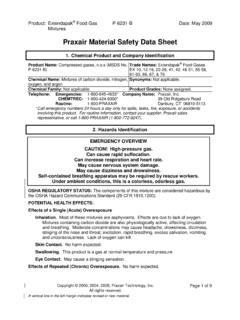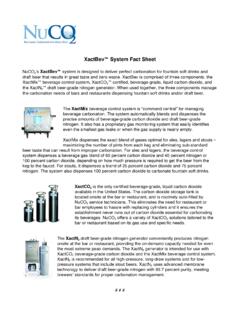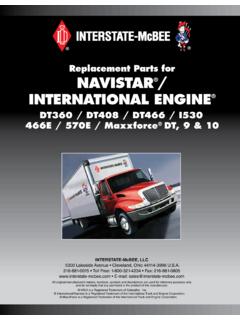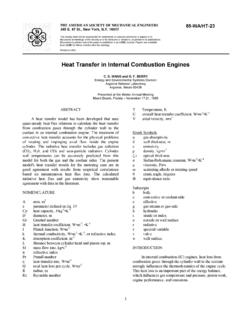Transcription of Praxair Safety Data Sheet - NuCO2: Beverage and …
1 Praxair Safety data Sheet Product: Carbon Dioxide SDS No. P-4574-K March 2013 A vertical line in the left margin indicates revised or new material. This is a general revision; please read entire document. Copyright 1980, 1985, 1986, 1989, 1991-1993, 1997, 1999, 2004, 2007, 2013, Praxair Technology, Inc. All rights reserved. Page 1 of 12 1. Identification Product Identifier: Carbon Dioxide Trade Names: Carbon Dioxide, Medipure Carbon Dioxide Recommended Uses: Industrial: analytical, lasers; semiconductor process gas; supercritical fluid extraction Restrictions on Use: Use only as directed. Supplier: Praxair , Inc., 39 Old Ridgebury Road Danbury, CT 06810-5113 USA Emergency Telephone Numbers: * Onsite emergencies: 1-800-645-4633 CHEMTREC: USA: 1 -800-424-9300 International: 001-703-527-3887, Contract: 17729 * Call emergency numbers only for spills, leaks, fire, exposure, or accidents involving this product.
2 For routine information, contact your supplier, Praxair sales representative, or call 1-800-772-9247. 2. Hazards Identification EMERGENCY OVERVIEW WARNING! Liquefied gas under pressure. Contains gas and liquid under pressure; may explode if heated. Can cause rapid suffocation. May cause dizziness and drowsiness. Can increase respiration and heart rate. May cause nervous system damage. May cause frostbite. OSHA REGULATORY STATUS: This material is considered hazardous by the OSHA Hazard Communications Standard (29 CFR ). Hazard Classification: Gases Under Pressure Liquefied Gas Precautionary Statements: Protect from sunlight. Store in a well-ventilated place. Praxair Safety data Sheet Product: Carbon Dioxide SDS No.
3 P-4574-K March 2013 Page 2 of 12 3. Composition/Information on Ingredients This section covers materials of manufacture only. See sections 5, 8, 10, 11, and 16 for information on by-products generated during use in welding and cutting or as a result of exposure to fire. See section 16 for important information about mixtures. Chemical Name Common Name and Synonyms CAS NUMBER CONCENTRATION Carbon Dioxide Carbonic anhydride, carbonic acid gas, refrigerant gas R744 124-38-9 >99% * The symbol > means greater than. 4. First Aid Measures INHALATION: Immediately remove to fresh air. If not breathing, give artificial respiration. If breathing is difficult, qualified personnel may give oxygen. Call a physician.
4 SKIN CONTACT: For exposure to cold vapor or solid carbon dioxide (dry ice), immediately warm frostbite area with warm water not to exceed 105 F (41 C). In case of massive exposure, remove contaminated clothing while showering with warm water. Call a physician. EYE CONTACT: For exposure to cold vapor or solid carbon dioxide (dry ice), immediately flush eyes thoroughly with warm water for at least 15 minutes. Hold the eyelids open and away from the eyeballs to ensure that all surfaces are flushed thoroughly. See a physician, preferably an ophthalmologist, immediately. SWALLOWING: An unlikely route of exposure. This product is a gas at normal temperature and pressure. NOTES TO PHYSICIAN: Treatment of overexposure should be directed at the control of symptoms and the clinical condition of the patient.
5 5. Fire Fighting Measures FLAMMABLE PROPERTIES: Nonflammable Protective Equipment and Precautions for Firefighters: Firefighters should wear personal protective equipment and fire-fighting turnout gear as appropriate for surrounding fire. SUITABLE EXTINGUISHING MEDIA: Carbon dioxide cannot catch fire but cylinders exposed to fire may explode. Use media appropriate for surrounding fire. PRODUCTS OF COMBUSTION: Not applicable. PROTECTION OF FIREFIGHTERS: WARNING! High-pressure liquid and gas. Evacuate all personnel from danger area. Immediately deluge cylinders with water from maximum distance until cool; then move them away from fire area if without risk. Self-contained breathing apparatus may be required by rescue workers.
6 On-site fire brigades must comply with OSHA 29 CFR and applicable standards under 29 CFR 1910 Subpart L Fire Protection. Praxair Safety data Sheet Product: Carbon Dioxide SDS No. P-4574-K March 2013 Page 3 of 12 Specific Physical and Chemical Hazards: Heat of fire can build pressure in cylinder and cause it to rupture. No part of cylinder should be subjected to a temperature higher than 125 F (52 C). Carbon dioxide cylinders are typically equipped with a pressure relief device. (Exceptions may exist where authorized by DOT.) 6. Accidental Release Measures STEPS TO BE TAKEN IF MATERIAL IS RELEASED OR SPILLED: WARNING! High-pressure liquid and gas. Rapid release of gaseous carbon dioxide through a pressure relief device (PRD) or valve can result in the formation of dry ice, which is very cold and can cause frostbite.
7 PERSONAL PRECAUTIONS: Carbon dioxide is an asphyxiant. Lack of oxygen can kill. Use self-contained breathing apparatus where needed. See Section 11. PERSONAL PROTECTIVE EQUIPMENT (PPE): See Section 8, Exposure Control/Personal Protection. EMERGENCY PROCEDURES: Evacuate all personnel from danger area. Shut off leak if you can do so without risk. Ventilate area or move cylinder to a well-ventilated area. Test for sufficient oxygen, especially in confined spaces, before allowing reentry. Methods and Materials for Containment and Cleaning Up: Prevent waste from contaminating the surrounding environment. Discard any product, residue, disposable container, or liner in an environmentally acceptable manner, in full compliance with federal, state, and local regulations.
8 If necessary, call your local supplier for assistance. 7. Handling and Storage PRECAUTIONS TO BE TAKEN IN HANDLING: Protect from sunlight. Avoid breathing gas. Do not get liquid in eyes, on skin, or clothing. Protect cylinders from damage. Use a suitable hand truck to move cylinders; do not drag, roll, slide, or drop. Never attempt to lift a cylinder by its cap; the cap is intended solely to protect the valve. Never insert an object ( , wrench, screwdriver, pry bar) into cap openings; doing so may damage the valve and cause a leak. Use an adjustable strap wrench to remove over-tight or rusted caps. Open valve slowly. If valve is hard to open, discontinue use and contact your supplier. Keep cylinder upright when in use.
9 Never apply flame or localized heat directly to any part of the cylinder. High temperatures may damage the cylinder and could cause the pressure relief device to fail prematurely, venting the cylinder contents. For other precautions in using carbon dioxide, see section 16. PRECAUTIONS TO BE TAKEN IN STORAGE: Store in a well-ventilated place. Gas can cause rapid suffocation due to oxygen deficiency. Store and use with adequate ventilation. Store only where temperature will not exceed 125 F (52 C). Carbon dioxide is heavier than air. It tends to accumulate near the floor of an enclosed space, displacing air and pushing it upward. This creates an oxygen-deficient atmosphere near the floor or in pits and trenches.
10 Ventilate space before entry. Verify sufficient oxygen concentration. Close cylinder valve after each use; keep closed even when empty. Prevent reverse flow. Reverse flow into Praxair Safety data Sheet Product: Carbon Dioxide SDS No. P-4574-K March 2013 Page 4 of 12 cylinder may cause rupture. Use a check valve or other protective device in any line or piping from the cylinder. Do not strike an arc on the cylinder. The defect produced by an arc burn could lead to cylinder rupture. Do not ground the cylinder or allow it to become part of an electrical circuit. Firmly secure cylinders upright to keep them from falling or being knocked over. Screw valve protection cap firmly in place by hand. Store full and empty cylinders separately.















